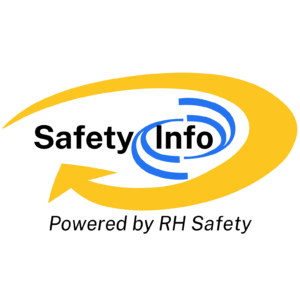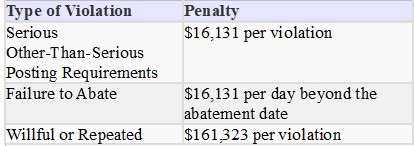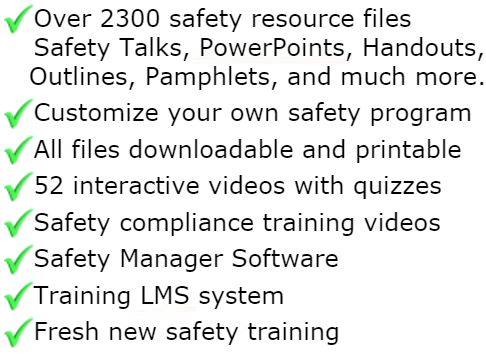
Crane & Hoist Safety
Many types of cranes, hoists, and rigging devices are used for lifting and moving materials. Crane and Sling safety policies are designed maintain a safe workplace. Only qualified and licensed people may operate cranes. To a crane operator, few experiences can be as frightening as when a crane becomes unbalanced while a load is being lifted or when the crane collapses under the weight of an excessive load.
Manufacturer's instructions must be followed when operating cranes hoists and slings. Attach the load to the block hook by means of slings or other approved devices, making sure the sling is clear of all obstacles. Once the load is properly secured and balanced in the untwisted sling, slowly raise the load. Horizontal movement must also begin slowly to prevent the load from swinging or coming into contact with other obstacles.
The crane warning signal or horn must be sounded when the load or hook comes near or over personnel. Carrying loads over personnel is not recommended. A load should not be left suspended.
Audible and discernible voice communication should be kept with the operator at all times. If this cannot be accomplished, a signal system should be used. Standard signals as shown on the next page; however, it may be necessary to create special signals in certain circumstances. In these circumstances, the signals must be understood and agreed upon by all individuals using the crane. .
Moving large, heavy loads is crucial to today's manufacturing and construction industries. Much technology has been developed for these operations, including careful training and extensive workplace precautions. There are significant safety issues to be considered, both for the operators of the diverse "lifting" devices, and for workers in proximity to them. This page is a starting point for finding information about these devices, including elevators and conveyors, and their operation.
All overhead cranes are required to have characteristics to promote their safe use. The OSHA regulation specifies design requirements on the construction of the cab and its controls; foot-walks, ladders and stairways; bridge and trolley bumpers; hoist, holding, trolley and bridge brakes; electrical components; hoisting equipment; and warning devices.
Routine crane and hoist inspections are required to ensure continued safe crane and hoist operations of the crane and the safety of the employees around the crane. An initial inspection of the crane prior to initial use of new and altered cranes is necessary. Once placed into service, overhead cranes will require two different types of inspections. Frequent inspections are done at daily to monthly intervals, while periodic inspections are completed at monthly to annual intervals. The purpose of the two inspection types is to detect critical components of the crane and to determine the extent of wear, deterioration or malfunction.
All materials in the members area for this topic index
Program Material | ||
Programs (written) | (2) | |
| Crane And Hoist Safety Program | Download | |
| Critical Lifts Safety Program | Download | |
Program Development | (1) | |
| Mechanical Material Handling Program Development | Download | |
Forms & Documents | ||
Checklists | (2) | |
| Crane Qualification Checklist | Download | |
| Critical Lift Checklist | Download | |
Forms | (2) | |
| Crane Hand Signals Form | Download | |
| Crane Operator License Form | Download | |
Inspections | (4) | |
| Chain Sling Inspection Form | Download | |
| Hoist And Auxiliary Equipment Inspection General Form | Download | |
| Hoists Cranes And Derricks Construction Inspection Form | Download | |
| Rigging Inspection Form | Download | |
Training Material | ||
Accident Reports | (1) | |
| Cranes Accident | Download | |
PowerPoints | (2) | |
| Overhead Crane Safety PowerPoint Spanish | Download | |
| Overhead Crane Safety PowerPoint | Download | |
Talks | (2) | |
| Construction Rigging Talk | Download | |
| Maint Cranes Slings Talk | Download | |

GET INSTANT ACCESS
to THE MEMBERS LIBRARY
Safety materials created by safety professionals.
Access to the Safety Manager software.
Wide variety of safety videos and courses.
**Brand New** Safety Training Management System
Pre-Made Safety Materials Ready For Use
Created by experienced safety professionals & risk consultants. Saving you time, money, and risk of injuries.
95% of the work already done.
Below are the maximum penalty amounts, with the annual adjustment for inflation, that may be assessed after Jan. 15, 2024. (See OSHA Memo, Jan. 8, 2024).

**New OSHA HEAT 90 DAY**
>>Download Free HERE<<
**New 2024 OSHA 300 Form**
>>Download Free HERE<<
**Brand New**
Free with full membership subscription
Training LMS System
Ask The Safety Consultant
Safety Equipment Deal Finder

“SafetyInfo.com is the first go-to website for safety professionals and companies to use in establishing a solid safety program"
-Mike McKenzie, Certified Safety & Health Manager (CSHM), McSafety Solutions™
Note: You must have a full subscription to the Safety Library in order to use this material. Any use outside of your organization, for resell, or without an active membership is strictly prohibited and may result in prosecution under copyright infringement laws. Please contact us first, if you would be interested in reselling or using our materials for reproduction.
Inside the Members Library
Topic Index
Accident Prevention
Air Quality
Asbestos
Bloodborne Pathogens
Boilers
Chemical Safety
Compressed Gas
Confined Space
Construction
Construction Worksite
Cranes & Slings
Driver / Fleet Safety
Drug Free Workplace
Electrical
Emergency Management
Engineering Safety
Environmental
Equipment
Ergonomics
Fall Protection
Fire Safety & Prevention
First Aid
Flammable Materials
Forklifts
Hazard Communication
Hazardous Materials
Hearing Protection
Heat Stress
Hot Work
Housekeeping
Job Safety Analysis
Laboratory
Ladders
Lead
Lockout-Tagout
Machinery & Equipment
Material Handling
MSDS (SDS)
Medical & First Aid
Occupational Health
Office Safety
Off the Job Safety
Personal Protection
Process Safety
Record Keeping
Respiratory Protection
Silica Safety
Rules & Policies
Signs & Labels
Slips, Trips & Fall
Training
Terrorism Programs
Tool Safety
Vehicle & Driver
Violence Programs
Welding & Hot Work
Training Videos
Library Index
Training Materials
Videos/Courses
Talks
Articles
PowerPoint
Handouts
Training Overheads
Quizzes
Supervisor Briefs
Management Briefs
Safety Sessions
2 Minute OSHA Safety Talks
Pamphlets
First Aid Training
Supervisor Training
Hazardous Materials
Bomb Threat
Crossword Puzzles
Biological Agents
Forms & Documents
Forms
Checklists
Audit Guides
Inspections Guides
Signs & Labels
Environmental Audit Guides
Recordkeeping - OSHA 300
Sign & Label Maker
Safety Management Resources
Safety Manuals/Written Programs
Ergonomic Programs
Emergency Plans
Process Safety Management
Construction Safety
Occupational Health
Environmental
Topic Sheets
DOT Fleet-Driver
Hazardous Materials
Chemical Safety
Drug Free Workplace
Terrorism Programs
Development Guides
Safety Manager Software
Safety References & Graphics
Technical Safety Information
Posters
Topic & Fact Sheets
Development Information
Job Specific Safety Rules
Terrorism
Calculators
Safety Comic Strips
New Safety Training System
Schedule and train your employees with our materials. Add unlimited amount of employees. Record all progress and issue certificates. For group and individual training sessions.

